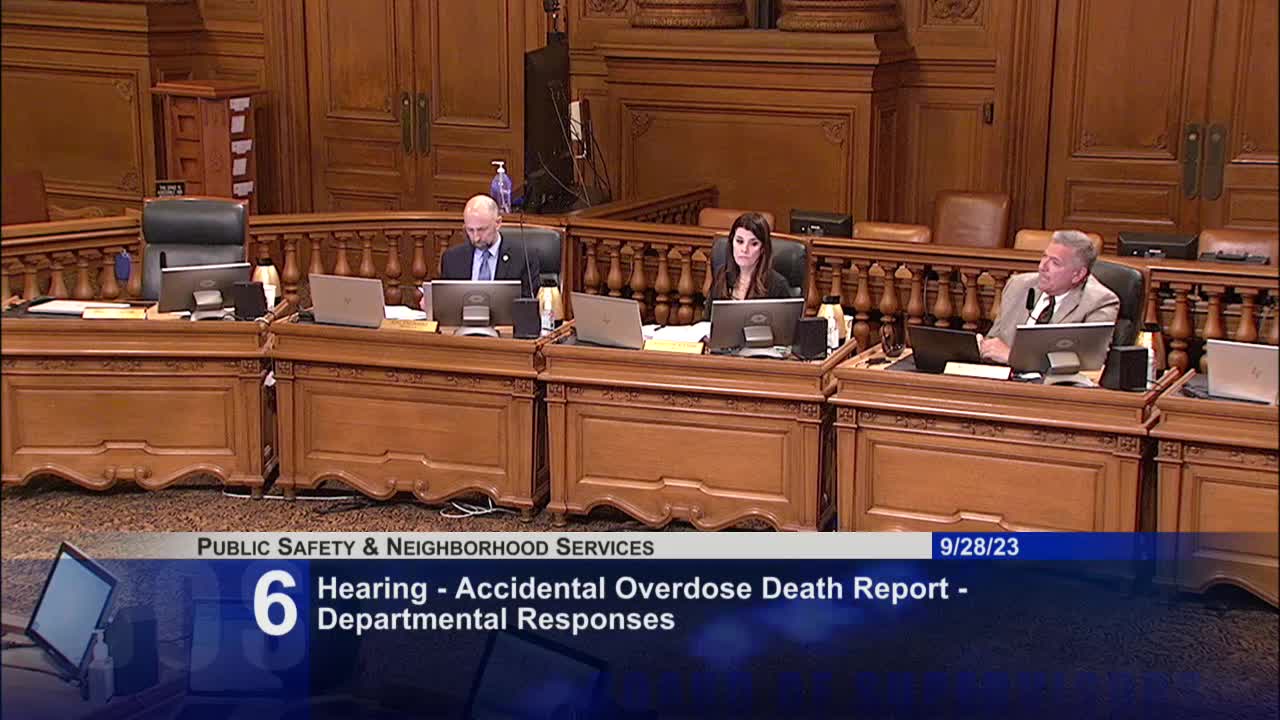San Francisco officials address fentanyl crisis and public safety concerns
September 28, 2023 | San Francisco County, California
This article was created by AI summarizing key points discussed. AI makes mistakes, so for full details and context, please refer to the video of the full meeting. Please report any errors so we can fix them. Report an error »

The San Francisco County Board of Supervisors convened on July 4, 2025, to address the escalating crisis of drug use and trafficking in the city, particularly the devastating impact of fentanyl. Supervisors and law enforcement officials expressed deep concern over the alarming rise in public drug use and the brazen drug dealing that has become increasingly visible in neighborhoods like the Tenderloin and South of Market.
During the meeting, a supervisor highlighted the urgency of the situation, stating that fentanyl dealing represents the deadliest crime in San Francisco's history. The supervisor emphasized the need for government leaders to take decisive action, as public confidence in government is waning amid visible lawlessness. They proposed legislative measures to hold drug dealers accountable, suggesting that judges and prosecutors should be made aware of the lethal consequences of their actions during court proceedings.
Commander Derek Lewis of the San Francisco Police Department outlined the department's strategic response to the crisis, including the establishment of the Drug Market Agency Coordination Center (DMACC). This initiative aims to disrupt drug trafficking and reduce the supply of illegal narcotics through increased enforcement and collaboration with federal agencies. Lewis reported significant increases in arrests related to drug trafficking and a notable rise in fentanyl seizures, indicating a more aggressive approach to tackling the drug crisis.
The meeting also addressed the need for better coordination between law enforcement and public health officials. Concerns were raised about the lack of investigations into overdose deaths, with calls for a dedicated unit to track down those responsible for supplying fatal drugs. The Department of Public Health (DPH) presented its ongoing efforts to combat the overdose crisis, including community engagement initiatives and the distribution of naloxone, a medication that can reverse opioid overdoses.
DPH officials reported that overdose deaths are disproportionately affecting Black and African American communities, highlighting the urgent need for targeted interventions. They outlined a comprehensive approach to overdose prevention that includes education, treatment access, and community partnerships.
As the meeting concluded, supervisors and officials acknowledged the complexity of the drug crisis and the necessity for a multifaceted response that addresses both supply and demand. The discussions underscored a collective commitment to finding effective solutions to save lives and restore safety in San Francisco neighborhoods. The board plans to follow up on these initiatives and continue collaborating with various city departments to tackle this pressing public health issue.
During the meeting, a supervisor highlighted the urgency of the situation, stating that fentanyl dealing represents the deadliest crime in San Francisco's history. The supervisor emphasized the need for government leaders to take decisive action, as public confidence in government is waning amid visible lawlessness. They proposed legislative measures to hold drug dealers accountable, suggesting that judges and prosecutors should be made aware of the lethal consequences of their actions during court proceedings.
Commander Derek Lewis of the San Francisco Police Department outlined the department's strategic response to the crisis, including the establishment of the Drug Market Agency Coordination Center (DMACC). This initiative aims to disrupt drug trafficking and reduce the supply of illegal narcotics through increased enforcement and collaboration with federal agencies. Lewis reported significant increases in arrests related to drug trafficking and a notable rise in fentanyl seizures, indicating a more aggressive approach to tackling the drug crisis.
The meeting also addressed the need for better coordination between law enforcement and public health officials. Concerns were raised about the lack of investigations into overdose deaths, with calls for a dedicated unit to track down those responsible for supplying fatal drugs. The Department of Public Health (DPH) presented its ongoing efforts to combat the overdose crisis, including community engagement initiatives and the distribution of naloxone, a medication that can reverse opioid overdoses.
DPH officials reported that overdose deaths are disproportionately affecting Black and African American communities, highlighting the urgent need for targeted interventions. They outlined a comprehensive approach to overdose prevention that includes education, treatment access, and community partnerships.
As the meeting concluded, supervisors and officials acknowledged the complexity of the drug crisis and the necessity for a multifaceted response that addresses both supply and demand. The discussions underscored a collective commitment to finding effective solutions to save lives and restore safety in San Francisco neighborhoods. The board plans to follow up on these initiatives and continue collaborating with various city departments to tackle this pressing public health issue.
Don't Miss a Word: See the Full Meeting!
Go beyond summaries. Unlock every video, transcript, and key insight with a Founder Membership.
✓
Get instant access to full meeting videos
✓
Search and clip any phrase from complete transcripts
✓
Receive AI-powered summaries & custom alerts
✓
Enjoy lifetime, unrestricted access to government data
30-day money-back guarantee

